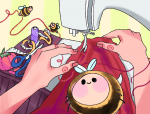Shoshanna Gruss has been planning the release of her most recent clothing line for 20 years – ever since she graduated from UCLA.
Gruss produced C’est Nous by Shoshanna, a size-inclusive extension of her own brand, Shoshanna, in collaboration with Gwynnie Bee, an online clothing subscription. The line offers a mixture of casual and professional dresses in sizes 0 to 32. The collaboration marks a step toward her goal to create more inclusive clothing, hurdling the financial constriction that held her back in the early days of the brand, Gruss said.
“When I first started, inclusive sizing was really not a priority for manufacturers. There was no H&M or Target the way we know it, and the higher end stores like Bloomingdale’s would only have a small selection,” Gruss said. “It just wasn’t a category people paid attention to.”
While Gruss’ plan to produce the line only came into fruition in January, her own brand Shoshanna launched 20 years ago. In designing her first collections, she said the people producing her line established that mainstream retail was only selling sizes 0 to 12. However, she said extending size options for her first lines proved unrealistic, considering her brand was confined to the start-up budget of a young mom.
Preferring the term “size-inclusive” to “plus-size,” Gruss said she sees C’est Nous as a celebration of different body types. Identifying as a woman who didn’t fit into the specific mold manufacturers thought women should look like, Gruss faced her own struggles in finding the right fit.
“I was born what I was born. I used to feel super crappy when I was younger when nothing looked right,” Gruss said. “I was like, ‘Wait a minute – no one is making clothes that fit me.'”
Gruss said in the past she has had to buy two sets of the same swimsuit in differences sizes to get the right fit or even had to have them custom-made. Sourcing motivation from feeling like an outlier in the sizing world ultimately gave her the push to expand her brand’s reach, she said. More importantly, Gruss said the variety in sizes allowed for people to mix and match styles of differing measurements. Arguing that stores would never sell underwear and bras as a set but continued to sell items like bathing suits in sets, Gruss insisted on size 13 tops and size 8 bottoms in her own collection.
“When we started thinking about it again, about two years ago, especially with more outlets that had extended sizes, we were wanting to do it right and reach this great market with Gwynnie Bee,” Gruss said.
In addition to the collaboration, Francesca de la Rama, a buyer for Gwynnie Bee, said the brand aims to make such items more affordable, particularly concerning the more expensive pieces in Shoshanna’s C’est Nous line. While the service carries dresses ranging from around $400 to $700 in retail prices, Gwynnie Bee offers its clients substantially discounted prices should clients like the pieces enough to permanently add them to their wardrobe, said de la Rama.
Shiho Makimura, a senior buyer for Gwynnie Bee, said that because Gwynnie Bee is a rental service, its clients are only paying for the monthly service, which costs around $69 monthly after a first month free. Within the line, no sizes are marked as “plus” or “inclusive sizing,” creating a more inviting shopping experience for buyers of all shapes and sizes, Gruss said.
“It’s great that brands like Shoshanna are willing to work with us to expand their size range and that more and more retailers are realizing the opportunity to extend their sizes,” Makimura said.
Examining the larger world of high fashion, Gruss says the market also needs to address the women willing to invest in expensive pieces of more inclusive sizing, something she said her own company attempts to do by offering some dresses priced at around $500. Still, she said there aren’t many women fitting into that bracket of luxury buyers, so her mission is to offer the same quality and tailoring that comes from a designer piece to her clientele’s wardrobes.
While Gruss acknowledges there is some testing of inclusive sizing in the more high fashion market, it is clear to her that it still sits in the extremes, remaining inaccessible to her average client, she said. In this sense, Gruss said she sees her clothing as a medium bridging affordability and specialized design to women who are willing and able to pay around $250 for a good quality dress. While maintaining that the fashion market will be slower to expand its sizing, with magazines and blogs in tow, Gruss said she is hopeful for more inclusive sizing to join her in the industry.
“At the end of the day, I think that designers want their customers to be happy and they want to make money, so if they see that there’s money in these markets and women want to spend that money, I’m sure that they will move into those categories soon,” she said.
